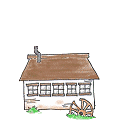









"the qualities of these bacteria, like the heat of the sun, electricity, or the qualities of metals, are part of the storehouse of knowledge of all men. They are manifestations of the laws of nature, free to all men and reserved exclusively to none." SCOTUS, Funk Bros. Seed Co. v. Kale Inoculant Co.









"Although the world is full of suffering, it is full also of the overcoming of it." - Helen Keller
--
Jeremiah Bailey
Central Indiana





jeremiah bailey wrote:
I always make several concentric rings around trees, with the side discharge facing away. A mulch, living or other, bed helps too. I've started using a mulcher, but I still have the habit of making several rings around trees, with the tree to the left of the mower. The same goes for other obstacles as well. I make several passes with the mower blowing away from the obstacle. Mulching around trees helps alot for other reasons. Competition, water conservancy, etc. I try to keep the mulch bed out to nearly the drip line.
 But also, with the high lift blades in, it blows it quite far, more than the 1 or two mower deck widths margin I try to put around the trees. Most of the time I'm not as worried about the latter situation, mulch is mulch as long as it's not coming at you at 60 MPH! And at a couple deck widths away it's not coming that fast. It's the "Oh crap, did I just pass by that twig with my chute right next to it (or even the edge of the mulch circle)?"
But also, with the high lift blades in, it blows it quite far, more than the 1 or two mower deck widths margin I try to put around the trees. Most of the time I'm not as worried about the latter situation, mulch is mulch as long as it's not coming at you at 60 MPH! And at a couple deck widths away it's not coming that fast. It's the "Oh crap, did I just pass by that twig with my chute right next to it (or even the edge of the mulch circle)?"  I guess I'm making them stronger! Which they need with some of the Mother Nature wind we get round here sometimes!
I guess I'm making them stronger! Which they need with some of the Mother Nature wind we get round here sometimes!







 Barring that, just consider it "hardening off."
Barring that, just consider it "hardening off.""Although the world is full of suffering, it is full also of the overcoming of it." - Helen Keller
--
Jeremiah Bailey
Central Indiana





jeremiah bailey wrote:
Mulching set ups kind of do the same, especially when you get rather thick areas. They don't discharge per se, so it tends to build up mass in the deck. When you get to a thinner area, or tilt/raise the deck, it clears.
jeremiah bailey wrote:
Maybe you need to put orange road cones around them. Or a proximity sensor that triggers an air horn. Or both, just so the neighbors really love ya!Barring that, just consider it "hardening off."





That's the part the tends to thicken up the deposits on the underside of my deck, I think. My favorite part of mowing my "wastelands" (the part in the far back of my property that I hardly take care of that didn't get seeded very well that the big/ugly/woody/what-have-you weeds own) is mowing over the dead, thick, straw-almost-woody weeds, imagining them kind of sandblasting my underdeck and chute as they blow around and out.
"Although the world is full of suffering, it is full also of the overcoming of it." - Helen Keller
--
Jeremiah Bailey
Central Indiana




jeremiah bailey wrote:
Imagining is one thing. Does that actually work? I hate lifting my deck to clean out the buildup. If it does, I might have to find a vacant, overgrown lot to mow.
"the qualities of these bacteria, like the heat of the sun, electricity, or the qualities of metals, are part of the storehouse of knowledge of all men. They are manifestations of the laws of nature, free to all men and reserved exclusively to none." SCOTUS, Funk Bros. Seed Co. v. Kale Inoculant Co.





jeremiah bailey wrote:
Imagining is one thing. Does that actually work? I hate lifting my deck to clean out the buildup. If it does, I might have to find a vacant, overgrown lot to mow.




Brenda
Bloom where you are planted.
http://restfultrailsfoodforestgarden.blogspot.com/





Jeremy Bunag wrote:
Does it clean down to the metal? Not with what I mow. I think if you did polyp's (OK, maybe that's a bad abbrev...sorry) wood chip idea, that would make a nice blender that could loosen some of the harder stuff, but I think you might sacrafice blade sharpness a bit.
I know that the chute has gotten crusty and then un-crustied by mowing the thick dry weeds. I guess the worst hurt you could have mowing a vacant lot is getting some stowaways coming back to your lot!





 6
6




- Tim's Homestead Journal - Purchase a copy of Building a Better World in Your Backyard - Purchase 6 Decks of Permaculture Cards -
- Purchase 12x Decks of Permaculture Cards - Purchase a copy of the SKIP Book - Purchase 12x copies of Building a Better World in your Backyard
 2
2




Life is too short, plant a tree for those that follow.

 2
2




How Permies works: https://permies.com/wiki/34193/permies-works-links-threads
My projects on Skye: The tree field, Growing and landracing, perennial polycultures, "Don't dream it - be it! "

 4
4




Some places need to be wild

| I agree. Here's the link: http://stoves2.com |

